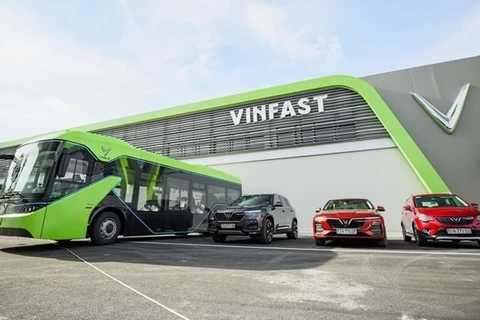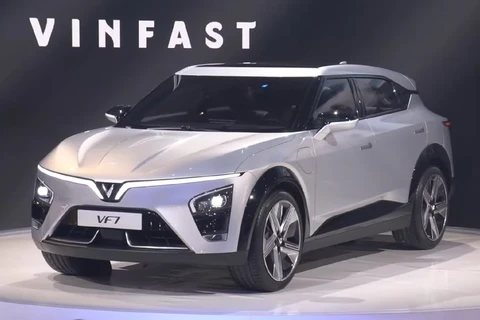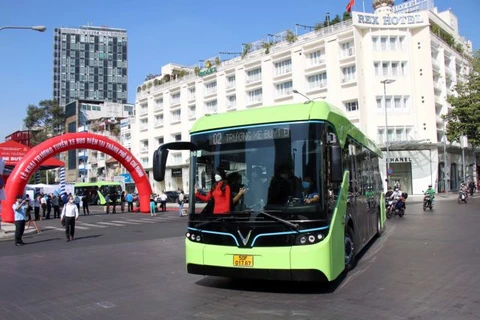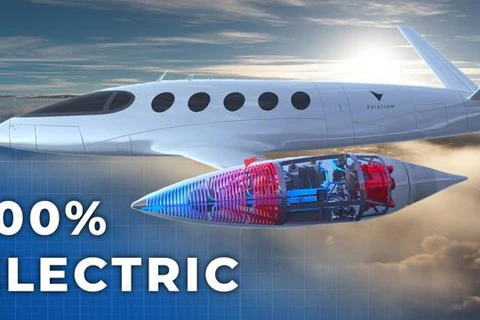Hanoi (VNA) - The capital city of Hanoi plans to convert 100% of its bus fleet from petrol-powered to electric ones as directed by the Government.
It will be part of goals and a roadmap for the implementation of an action programme on green energy transition, and carbon and methane emission reduction of the transport industry, which the municipal People's Committee has assigned the Department of Transport to build in coordination with relevant units.
Since the first electric buses were put into operation in Hanoi in December 2021, the number of bus routes using smart electric buses in the city has increased to nine, contributing to enhancing the quality of public transport in the capital city.
The service, provided by Vinbus Ecology Transport Services Limited Liability Company (VinBus), a member of Vietnam’s largest conglomerate Vingroup, is attracting a large number of users thanks to its high quality and no harm to the environment.
Each bus is equipped with an automated system able to give warnings about unsafe situations, an on-board public address system, free wifi, USB charging ports, and security cameras, among others.
With a battery capacity of 281 kWh, the bus can run between 220 and 260 kilometres on a single charge. It can fully recharge in just two hours at VinBus’s 150 kW charging station network.
Thai Ho Phuong, Vice Director of the city Public Transport Management Centre, said that in the first half of this year, electric buses carried over 122 million passengers, and the figure is increasing continuously.
With good feedback from users, in the time to come, the centre will work with VinBus to launch more routes, with an aim to attract more passengers to public transportation services and contribute to reducing air and noise pollution in city streets.
Meanwhile, the Hanoi Transport Corporation is currently operating 83 bus routes and one BRT route with a total number of nearly 1,100 vehicles. The number of vehicles eligible to be replaced by electric buses from 2025 is 225, accounting for 21.3% of the total.
Under the Government action programme on green energy transition, and carbon and methane emission reduction, Vietnam aims to have 100% of new buses use electricity or green energy from 2025.
It also targets that from 2030, at least half of all vehicles and all new taxis will be powered by electricity or green energy. By 2050, 100% of buses and taxis will use these types of energy.
The plan also looks to raise the rate of commuters carried by public transport to 45% - 50% in Hanoi, 25% in Ho Chi Minh City, 25% - 35% in Da Nang city, 20% in Can Tho city, 10% - 15% in Hai Phong city from 2025. The figure in these provincial-level cities is targeted at at least 40% by 2050.
The action plan’s overall goal is to develop a green transport system towards net zero emissions by 2050 as Vietnam committed to at the 26th United Nations Climate Change Conference (COP26).
The objective for 2030 is to improve energy use efficiency and boost the use of electricity and green energy in the fields that are ready in terms of technology, regulations and resources to help carry out the commitments in the Nationally Determined Contribution and reduce methane emissions.
From now to 2050, the transport sector will reasonably develop means of transport and strongly convert all vehicles, transport equipment and infrastructure into electric and green energy-powered vehicles towards net zero emissions.
For road transport, during 2022 - 2030, the plan looks to promote the production, assembly, import and use of electric vehicles, expand the use of biofuel E5 to all road vehicles, develop charging systems, and encourage both existing and new coach stations and rest areas to adopt green practices./.
It will be part of goals and a roadmap for the implementation of an action programme on green energy transition, and carbon and methane emission reduction of the transport industry, which the municipal People's Committee has assigned the Department of Transport to build in coordination with relevant units.
Since the first electric buses were put into operation in Hanoi in December 2021, the number of bus routes using smart electric buses in the city has increased to nine, contributing to enhancing the quality of public transport in the capital city.
The service, provided by Vinbus Ecology Transport Services Limited Liability Company (VinBus), a member of Vietnam’s largest conglomerate Vingroup, is attracting a large number of users thanks to its high quality and no harm to the environment.
Each bus is equipped with an automated system able to give warnings about unsafe situations, an on-board public address system, free wifi, USB charging ports, and security cameras, among others.
With a battery capacity of 281 kWh, the bus can run between 220 and 260 kilometres on a single charge. It can fully recharge in just two hours at VinBus’s 150 kW charging station network.
Thai Ho Phuong, Vice Director of the city Public Transport Management Centre, said that in the first half of this year, electric buses carried over 122 million passengers, and the figure is increasing continuously.
With good feedback from users, in the time to come, the centre will work with VinBus to launch more routes, with an aim to attract more passengers to public transportation services and contribute to reducing air and noise pollution in city streets.
Meanwhile, the Hanoi Transport Corporation is currently operating 83 bus routes and one BRT route with a total number of nearly 1,100 vehicles. The number of vehicles eligible to be replaced by electric buses from 2025 is 225, accounting for 21.3% of the total.
Under the Government action programme on green energy transition, and carbon and methane emission reduction, Vietnam aims to have 100% of new buses use electricity or green energy from 2025.
It also targets that from 2030, at least half of all vehicles and all new taxis will be powered by electricity or green energy. By 2050, 100% of buses and taxis will use these types of energy.
The plan also looks to raise the rate of commuters carried by public transport to 45% - 50% in Hanoi, 25% in Ho Chi Minh City, 25% - 35% in Da Nang city, 20% in Can Tho city, 10% - 15% in Hai Phong city from 2025. The figure in these provincial-level cities is targeted at at least 40% by 2050.
The action plan’s overall goal is to develop a green transport system towards net zero emissions by 2050 as Vietnam committed to at the 26th United Nations Climate Change Conference (COP26).
The objective for 2030 is to improve energy use efficiency and boost the use of electricity and green energy in the fields that are ready in terms of technology, regulations and resources to help carry out the commitments in the Nationally Determined Contribution and reduce methane emissions.
From now to 2050, the transport sector will reasonably develop means of transport and strongly convert all vehicles, transport equipment and infrastructure into electric and green energy-powered vehicles towards net zero emissions.
For road transport, during 2022 - 2030, the plan looks to promote the production, assembly, import and use of electric vehicles, expand the use of biofuel E5 to all road vehicles, develop charging systems, and encourage both existing and new coach stations and rest areas to adopt green practices./.
VNA
























